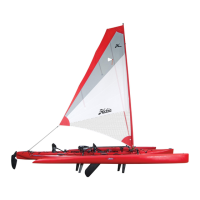12
TURNING
To tack or turn the boat into and across the wind to
the opposite direction (also known as "coming about"),
follow the points of the sail guide illustration and take
the boat to the close-hauled point of sail. This is when
you are nearly 35 degrees from sailing straight into the
wind. With the boat moving forward and not stalling,
turn the boat into the wind. When the boat is pointing
straight into the wind the boat will become level. Ease
the mainsheet trim out just a little. As the boat comes
across the wind and falls off onto the opposite, close-
hauled point of sail, turn the rudder back to the straight
position and adjust the mainsail back in for the proper
sail trim. If you make the tack and feel that the rudder is
fighting the turn, you likely have the sail sheeted in too
tight. Let the sail out a bit and turn the rudder to adjust
your course.
When sailing downwind, turning the boat from one point
of sail across to the other is called a "jibe". The jibe is
completed by turning away from the wind (in sailing
terms, “falling off”) to the opposite point of sail rather
than into the wind as when tacking. Care must be taken
when attempting a jibe in high winds as the boat will be
at full power and you cannot easily de-power it without
turning back into the wind.
of the sail. Follow the diagram below to get optimum
performance out of the sail for all angles of sailing. The
tell tails react to air flowing over the sail and will help
you determine if the sail is pulled in too tight or not
enough. If you pull the sail too tight you will stall the sail
power. Ease the sail out until the tell tails on both sides
are flying. You will adjust the trim whenever the wind
changes direction or when you change course.
To start a jibe, turn the boat away from the wind and let
the sail out slowly. Keep the turn going at a steady rate
and begin pulling the sail back in as the boat nears the
straight downwind direction. This will keep the sail from
slamming all the way across when the sail fills from the
opposite side. Duck below the sail to avoid getting hit as
the wind fills the sail from the opposite side and swings
across the boat. Attempt to control the speed of the sail
while it crosses the deck by maintaining some tension
on the mainsheet, then ease the mainsheet out quickly
as the boat turns past the downwind direction onto the
new point of sail. Trim the sail correctly for the desired
point of sail.
DOCKING
Properly docking the Tandem Island will prevent
damage. Always furl the sail and approach the dock
under power of the MirageDrive ®. As you approach the
dock, release the diagonal crossbrace on the outrigger
closest to the dock and pull it in next to the main hull.
Stretch the paddle holder Bungee over the eyelet post
on the aka to hold it in against the hull. Be aware of the
water depth as you may want to pull up the centerbaord
and rudder.
BEACH LANDINGS
Landing on a beach is simple. As you approach the
beach, furl your sail and retract the centerboard. Use
the MirageDrive to propel the kayak toward the beach.
As you reach the shore, put one pedal forward to raise
the fins and move the rudder into the “up” position.
Always keep the boat pointed into the wind while
beached and keep the sail furled.
REEFING FOR MORE PERFORMANCE
When sailing in high wind conditions, you may find that
the bow of the amas start to submerge and pierce the
water. To get some of the load off of the amas, reef
the sail down as shown on page 10. By eliminating the
drag from the submerged amas, you will improve the
performance of the Island in high wind conditions.

